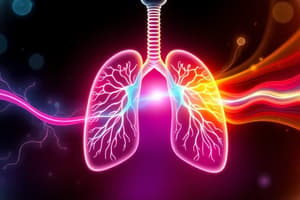Podcast
Questions and Answers
What is the main purpose of the breathing system?
What is the main purpose of the breathing system?
- To regulate carbon dioxide levels in the body
- To bring oxygen into the body and remove carbon dioxide (correct)
- To exchange oxygen and carbon dioxide between the environment and the body's cells
- To generate energy from the food we eat
What is the primary function of gas exchange surfaces?
What is the primary function of gas exchange surfaces?
- To break down glucose to produce ATP
- To transport oxygen from the lungs to the body's cells
- To facilitate gas diffusion between the environment and the body's cells (correct)
- To regulate carbon dioxide levels in the body
How does hemoglobin help in oxygen transport?
How does hemoglobin help in oxygen transport?
- By facilitating gas diffusion between the environment and the body's cells
- By regulating carbon dioxide levels in the body
- By breaking down glucose to produce ATP
- By binding to oxygen in the lungs, forming oxyhemoglobin (correct)
What is the primary function of the respiratory center?
What is the primary function of the respiratory center?
What is the purpose of the oxygen dissociation curve?
What is the purpose of the oxygen dissociation curve?
What is the main function of the diaphragm in the breathing system?
What is the main function of the diaphragm in the breathing system?
What is the primary function of chemoreceptors in carbon dioxide regulation?
What is the primary function of chemoreceptors in carbon dioxide regulation?
What is the purpose of buffering in carbon dioxide regulation?
What is the purpose of buffering in carbon dioxide regulation?
Flashcards are hidden until you start studying
Study Notes
Respiration
- Definition: The process of generating energy from the food we eat, involving the breakdown of glucose to produce ATP
- Stages:
- Breathing (inspiration and expiration): bringing oxygen into the body and removing carbon dioxide
- Gas exchange: exchange of oxygen and carbon dioxide between the environment and the body's cells
- Cellular respiration: breakdown of glucose to produce ATP
Gas Exchange Surfaces
- Definition: Specialized surfaces where gas exchange occurs between the environment and the body's cells
- Characteristics:
- Thin: to minimize distance for gas diffusion
- Moist: to facilitate gas diffusion
- Large surface area: to increase rate of gas exchange
- Examples:
- Lungs (alveoli)
- Gills (in fish)
- Tracheae (in insects)
- Skin (in some amphibians)
Oxygen Transport
- Definition: The process of transporting oxygen from the lungs to the body's cells
- Mechanisms:
- Hemoglobin (Hb): binds to oxygen in the lungs, forming oxyhemoglobin (HbO2)
- Oxygen dissociation curve: shows the relationship between oxygen partial pressure and HbO2 saturation
- Oxygen delivery: oxyhemoglobin releases oxygen to the body's cells
Carbon Dioxide Regulation
- Definition: The process of regulating carbon dioxide levels in the body
- Mechanisms:
- Buffering: maintaining pH levels by regulating carbon dioxide levels
- Respiratory center: controls breathing rate to regulate carbon dioxide levels
- Chemoreceptors: detect changes in carbon dioxide levels and trigger responses to maintain homeostasis
Breathing System
- Definition: The system responsible for bringing oxygen into the body and removing carbon dioxide
- Components:
- Nose and mouth: entrance points for air
- Trachea: tube that leads to the lungs
- Bronchi: tubes that branch into the lungs
- Lungs: organs responsible for gas exchange
- Diaphragm: muscle that separates the chest cavity from the abdominal cavity
- Mechanisms:
- Inspiration: diaphragm contracts, increasing chest cavity volume, and air enters the lungs
- Expiration: diaphragm relaxes, decreasing chest cavity volume, and air leaves the lungs
Respiration
- Respiration is the process of generating energy from the food we eat, involving the breakdown of glucose to produce ATP.
- The three stages of respiration are:
- Breathing (inspiration and expiration)
- Gas exchange
- Cellular respiration
Gas Exchange
- Gas exchange occurs between the environment and the body's cells through specialized surfaces.
- These surfaces have three characteristics:
- They are thin to minimize distance for gas diffusion.
- They are moist to facilitate gas diffusion.
- They have a large surface area to increase the rate of gas exchange.
- Examples of gas exchange surfaces include:
- Lungs (alveoli)
- Gills (in fish)
- Tracheae (in insects)
- Skin (in some amphibians)
Oxygen Transport
- Oxygen is transported from the lungs to the body's cells through the bloodstream.
- Hemoglobin (Hb) binds to oxygen in the lungs, forming oxyhemoglobin (HbO2).
- The oxygen dissociation curve shows the relationship between oxygen partial pressure and HbO2 saturation.
- Oxyhemoglobin releases oxygen to the body's cells, a process known as oxygen delivery.
Carbon Dioxide Regulation
- Carbon dioxide levels in the body are regulated through various mechanisms.
- Buffering maintains pH levels by regulating carbon dioxide levels.
- The respiratory center controls breathing rate to regulate carbon dioxide levels.
- Chemoreceptors detect changes in carbon dioxide levels and trigger responses to maintain homeostasis.
Breathing System
- The breathing system is responsible for bringing oxygen into the body and removing carbon dioxide.
- The components of the breathing system include:
- Nose and mouth
- Trachea
- Bronchi
- Lungs
- Diaphragm
- Inspiration occurs when the diaphragm contracts, increasing chest cavity volume, and air enters the lungs.
- Expiration occurs when the diaphragm relaxes, decreasing chest cavity volume, and air leaves the lungs.
Studying That Suits You
Use AI to generate personalized quizzes and flashcards to suit your learning preferences.



